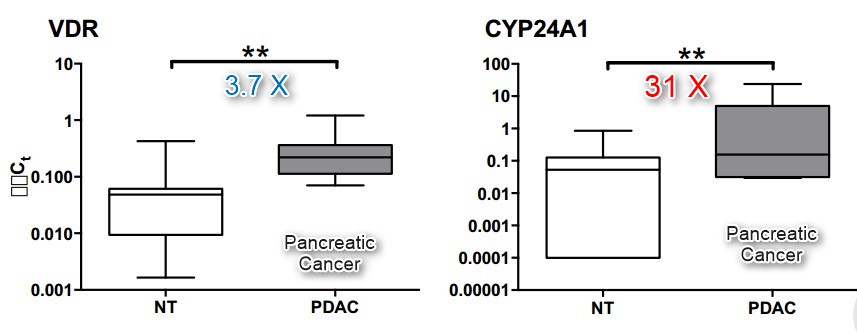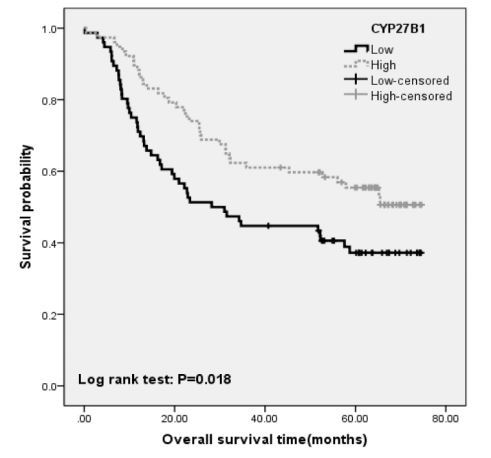Live longer with lung cancer if have good vitamin D genes (or perhaps lots of vitamin D)
Associations between abnormal vitamin D metabolism pathway function and non-small cell lung cancer.
Oncol Lett. 2017 Dec;14(6):7538-7544. doi: 10.3892/ol.2017.7162. Epub 2017 Oct 10.
Ge N1, Chu XM1, Xuan YP1, Ren DQ2, Wang Y1, Ma K1, Gao HJ1, Jiao WJ1.
 shaded text and numbers in the chart were added by Vitamin D LifeNote: this study did not consider the Vitamin D Receptor gene---* Lung cancer – reduced deaths if have a good vitamin D gene (CYP27B1) – Feb 2015 has the following chart*
shaded text and numbers in the chart were added by Vitamin D LifeNote: this study did not consider the Vitamin D Receptor gene---* Lung cancer – reduced deaths if have a good vitamin D gene (CYP27B1) – Feb 2015 has the following chart*  * Cancer patients 64% less likely to die if have high level of vitamin D – Dec 2011 has the following chart*
* Cancer patients 64% less likely to die if have high level of vitamin D – Dec 2011 has the following chart*  * Lung Cancer is up to 7 X more deadly if poor vitamin D genes – Oct 2021
* Lung Cancer is up to 7 X more deadly if poor vitamin D genes – Oct 2021📄 Download the PDF from Vitamin D Life
24A1 Active vitamin D is pissed away more than usual

27B1 Kidney does not activate as much Vitamin D

Lung cancer is a type of malignant tumor derived from the respiratory system, which is the leading cause of cancer-associated mortality worldwide, of which ~80% of cases are attributable to non-small cell lung cancer (NSCLC). A previous study demonstrated that 1α,25-Dihydroxyvitamin D3 (1α,25(OH)2D3), derived from the vitamin D metabolic pathway contributes an antitumor effect. Aberrant expression of the essential enzyme encoding genes, Cytochrome P450 Family 27 Subfamily A Member 1 (CYP27A1), Cytochrome P450 Family 27 Subfamily B Member 1 (CYP27B1), and Cytochrome P450 Family 24 Subfamily A Member 1 (CYP24A1) may be associated with lung cancer. However, a lack of evidence exists concerning the association between CYP27A1, CYP27B1, CYP24A1 expression and NSCLC. The aim of the present study was to investigate the functions of CYP27A1, CYP27B1 and CYP24A1 expression in NSCLC. Lung cancer tissue and para-carcinoma control tissue were collected from patients with NSCLC. Reverse transcription-quantitative polymerase chain reaction was applied to analyze CYP27A1, CYP27B1 and CYP24A1 mRNA expression in lung cancer tissues. An association analysis was performed between the aforementioned metabolic enzymes and patients with NSCLC age, gender, tumor node metastasis (TNM) stage, pathological type, differentiation and prognosis. CYP27B1 and CYP24A1 mRNA were upregulated in NSCLC compared with controls (P<0.05). However, no significant differences in CYP27A1 expression were observed between NSCLC and control. In addition, CYP24A1 expression was not associated with age, sex, smoking or TNM stage, but was associated with pathological type, differentiation and prognosis (P<0.05). CYP27B1 expression was significantly associated with TNM stage, differentiation, and prognosis, but not age, sex, smoking or pathological type. In conclusion, CYP27B1 and CYP24A1 may be considered as independent prognostic factors of NSCLC and may be novel therapeutic targets to assist clinical diagnosis, treatment and prognosis of the disease.
PMID: 29250167 PMCID: PMC5727627 DOI: 10.3892/ol.2017.7162
